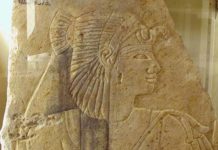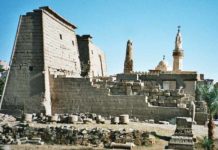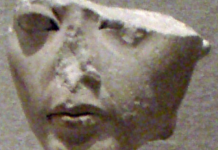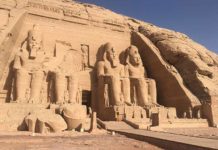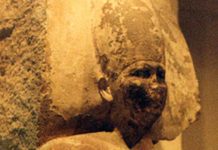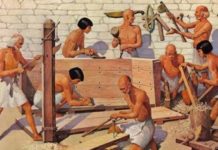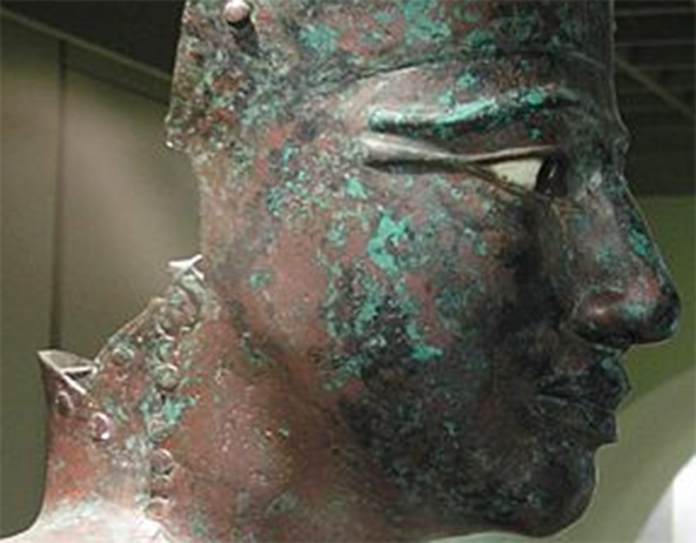
Pepy is said by Flinders Petrie to have left more monuments, large and small, than any other ruler before the Middle Kingdom. He built in both north and south: a ka-chapel at Bubastis in the Delta, reliefs bearing his name show him at Dendera, and he had building projects at Abydos, and Elephantine. His pyramid stands at Saqqara, near Giza.
Mennefer is Memphis
At this time Egypt’s royal national capital was at Ineb-Hedj, or White wall, the city founded, according to legend and the Ptolemaic historian Manetho, by Menes, unifier of Egypt. Ineb-Hedj, named perhaps for its fortifications, lay on the west bank of the Nile just south of what is now modern Cairo. Its importance was probably gradually replaced by more populated suburbs to the south. Pepy may have moved his palace further south from the old capital, away from the crowded city. Here at a location called Menneferpepy, in the valley east of the present South Saqqara, he built his pyramid.
The settlement that included both Pepy’s pyramid and its accompanying town took its name Mennefer from the pyramid, which name means Pepy is stable and perfect. This settlement and those around the Ptah temple further east, together with Ineb-Hebj itself, eventually all became known as Mennefer, which the Greeks wrote as Memphis.
Pepy as King
Pepy I was the son of King Teti and Queen Iput, and he reigned between 2354-2310 BCE. The name Pepy predated his accession to the throne, and was never actually used in ancient times, although it would appear within a cartouche, preceded by the signs meaning son of Ra. His Horus name was Merytawy and his prenomen was Nefersahor, meaning excellent is the protection of Horus, which he later changed to Meryra, meaning beloved of Ra.
His reign was one of the most prosperous in the Old Kingdom. A biennial census of cattle, which can be used to determine the length of rule, shows that Pepy reigned for at least fifty years. The Autobiography of Weni and various inscriptions are evidence that Pepy sent expeditions to the Wadi Hammamat and the copper mines at Sinai. Weni’s text also reports that he was entrusted to undertake several military expeditions against the Bedouins. Pepi’s presence is also indicated throughout Nubia. Many statues of kneeling prisoners, their arms linked, their faces representing many peoples from southern Africa and southwestern Asia, have been found at his pyramid complex at Saqqara by the French Archaeological Mission working there.
Pepy celebrated the sed-festival or jubilee in his 36th regnal year, as indicated by a small calcite statue of him seated wearing his sed-robe. Another statue, carved out of schist, shows the king kneeling, making an offering to the gods. A copper statue of Pepy shows him and his small son and heir Merenre.
Conspiracy in the Harem
A queen who is unnamed conspired against Pepy, perhaps early in his reign. Weni was at this time a lesser palace official, but in his autobiographical text he claims to have been so trusted by the king that he was empowered to secretly investigate the matter, by himself. The outcome is unclear, but Weni seems to have prospered well.
Queenly Sisters and Heirs
The king later married two sisters, daughters of Khui, an influential official of Abydos. Pepy’s first heir Merenra was born to Ankhnes-meryra I, and his second heir Pepy Netjerkhau was born to her sister Ankhnesmeryra II.
Pepy’s Pyramid
Pepy built his pyramid at South Saqqara. It was originally intended to rise 160 feet. Today it is in ruins, a mound only 32 feet high. However, in clearing the funerary chamber within, reliefs showing long sequences of the Pyramid Texts have been found.


